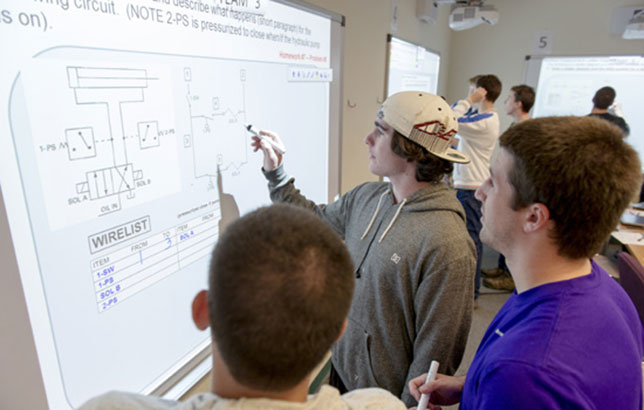RIT Opening Technology-Rich Classroom for STEM Courses
Tablets, projectors, cameras, interactive whiteboards, collaborative software and more will enhance STEM learning in a new classroom being dedicated this Friday at the Rochester Institute of Technology's College of Applied Science and Technology (CAST). The Technology Rich Interactive Learning Environment, or TRILE, aims "to transform education from predominantly lecture to more active learning, where students, especially those with lower GPAs or from under-represented groups, benefit from this non-traditional classroom setting," according to a statement from the school.
Development of the interactive classroom was led by Robert Garrick, associate professor in CAST's School of Engineering Technology, whose research has linked the use of immersive technologies and collaborative software with increased academic performance. Garrick worked with faculty within CAST's School of Engineering Technology and RIT's Kate Gleason College of Engineering, as well as with representatives from the University of Rochester's Warner School of Education.

RIT's TRILE classroom (Photo: Elizabeth Lamark/RIT Production Services) |
"The new TRILE space is unique in that it has 10 projectors to increase the visualization of material, 30 tablet computers, cameras and eight interactive whiteboards to allow students to actively participate in their learning by digitally inking problem solutions while working in groups," said Garrick in a press release.
Other tools and techniques and being incorporated into the classroom include: interactive software integrated with instructional materials in a shared, online workspace; embedded video links to real applications of course concepts; increased interactive activities to highlight different approaches to successfully complete problems; and immediate feedback and retrieval of information from class sessions. Garrick's research has found that this type of technology-enhanced learning boosts student outcomes, particularly in those who have struggled academically. It has also increased retention rates for students who typically would have withdrawn from the courses.
"The ongoing and future challenge for educators will be selecting and integrating immersive classroom technologies to enhance proven pedagogical principles," Garrick said.
The TRILE classroom was funded through the National Science Foundation's Research Initiation Grants in Engineering Education program and a grant from RIT's Innovative Learning Institute.
About the Author
Rhea Kelly is editor in chief for Campus Technology, THE Journal, and Spaces4Learning. She can be reached at [email protected].